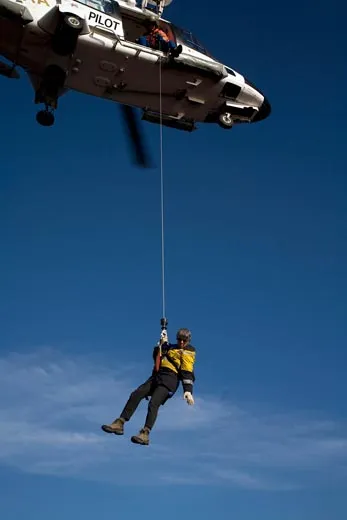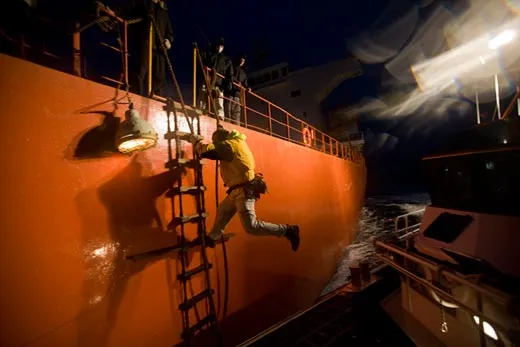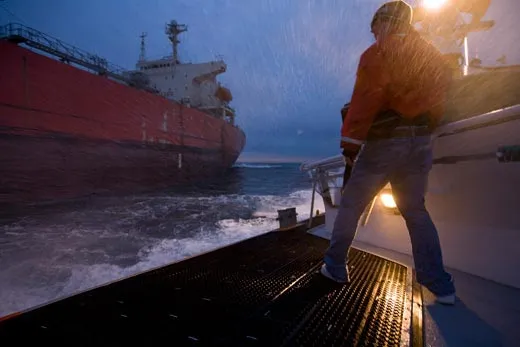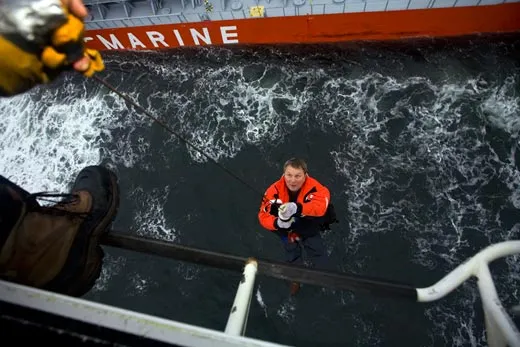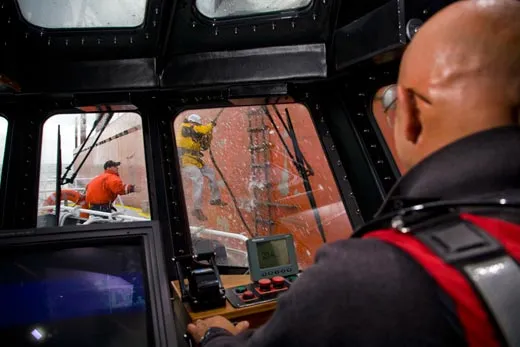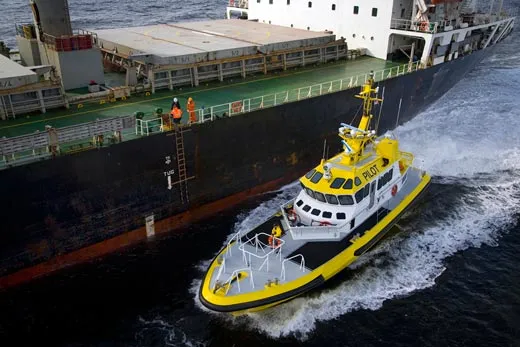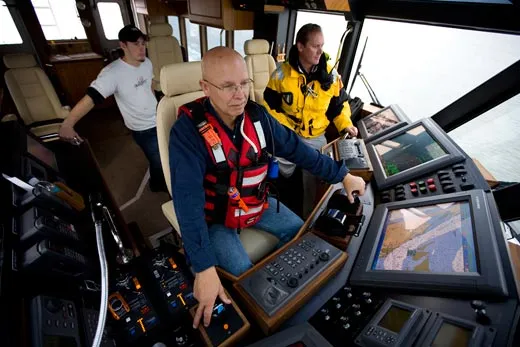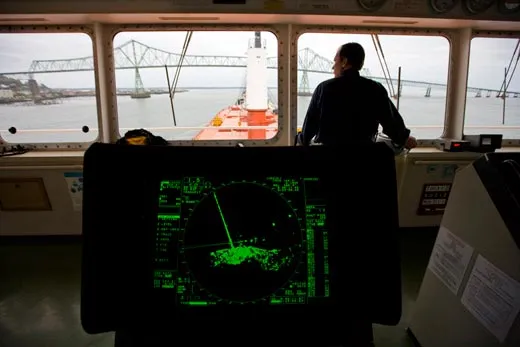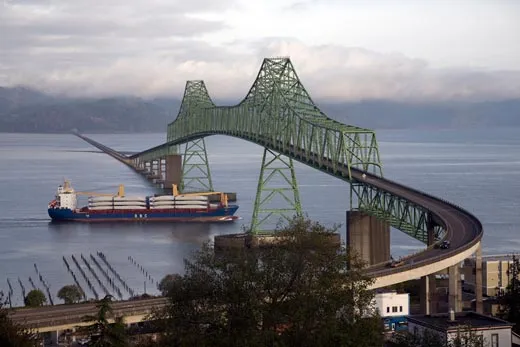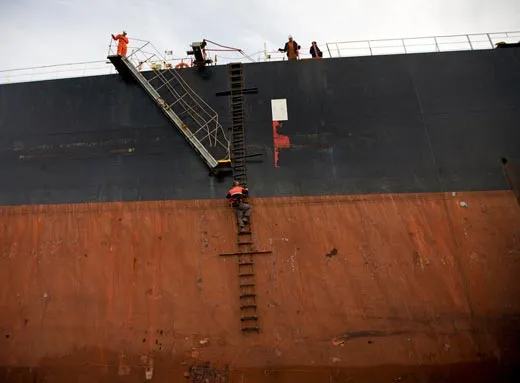Steering Ships Through a Treacherous Waterway
Braving storms with high seas a group of elite ship pilots steers tankers and freighters through the Columbia River
/https://tf-cmsv2-smithsonianmag-media.s3.amazonaws.com/filer/Dan-Jordan-descending-grain-ship-631.jpg)
At first light on a winter morning off the Oregon coast, the sky begins to luminesce the same creepy shade of doom you might expect at the Apocalypse. A gathering storm is chasing crab boats back to port, but the Chinook is running out to sea. Long as a locomotive and painted rubber-ducky yellow, it powers through the angry water with a thunderous boozh-boozh-babooozh! that sends explosions of spray hurtling past the pilothouse.
"She's built stout," yells Ken Olson, the boat's operator, and I want to believe. It feels as if we're riding a mechanical bull through a dunk tank, and I'm fighting the odd urge to yodel and retch simultaneously.
But this is just the morning commute for Capt. Dan Jordan, who routinely works in all manner of awful weather to guide ships into and out of the Columbia River. The bar, where the river's mighty current collides with ocean swells, is one of the most treacherous harbor entrances on the planet. Winter storms whip the sea into a ship-hungry maelstrom that long ago earned this patch of water the nickname "Graveyard of the Pacific." Pilots guide ships at every major harbor around the world, but the bar pilots here have distinguished themselves by working a potent brand of maritime mojo in the face of what a 19th-century naval officer called "the terrors of the bar."
Jordan has a rendezvous with the Rainbow Wing, a car carrier running in ahead of the storm with $72 million worth of vehicles fresh off the assembly line in Japan. And time is tight. "It's a pretty big storm out there," Jordan says. The forecast calls for 24-foot seas.
When the Rainbow Wing finally materializes out of the scud, a dozen miles out to sea, it looks like a ten-story-tall anvil plowing through the water. White-over-blue and as long as two football fields, it has "Honda" emblazoned big and red across its ample stern. Partway down the length of the ship, dangling like an afterthought, is a rope boarding ladder.
Olson cranks the Chinook around to maneuver alongside. Jordan turns up his radio, zips into his float coat—a self-inflating survival jacket—and heads out on deck. The Chinook rises and falls beneath the pilot ladder, and gobbets of spray fly through the air. Jordan bides his time until he can feel the rhythm of the swells. The boat's deck rises once more, and he launches himself for the fourth rung. He scrambles up the ladder as another welter of water blasts over the pilot boat.
Once aboard the Rainbow Wing, Jordan negotiates his way between the rows of gleaming CR-Vs on the cargo decks to the bridge. He confers with the captain and gets a quick feel for the way the ship moves through the water. "On a ship like this," Jordan says, "you need to think way far in advance of where you are. It's a big piece of steel we're driving here. If you're not on top of things, once you get in trouble, it's too late to get out."
He heads the Rainbow Wing toward the bar. Huge rollers roar ashore on both sides of the river entrance as he begins finessing the ship between the rock jetties and down the ship channel. When the Rainbow Wing finally arrives in Portland some 100 miles upriver, 80 longshoremen will drive the 3,508 vehicles off the ship.
The Rainbow Wing is the first of several ships that Jordan and his fellow pilots will try to sneak into port before the full fury of the storm arrives. It's highly technical, difficult, wet, dangerous work, little known outside the fraternity of harbor pilots. Yet these men—and one woman—are a crucial link in the global supply chains that make possible the 21st century's just-in-time economy.
Some 2,000 vessels and 700 souls have been lost on the Columbia River bar. Disaster has been written all over the chart ever since there was one. When the navy sloop Peacock arrived to map the area in 1841, it promptly wrecked on one of the sand spits bracketing the river's mouth—and the treacherous landmark was named Peacock Spit.
The bar pilots trace their heritage to 1813 and a one-eyed Chinook Indian chief named Concomly, who would paddle a canoe out to guide ships across the bar in exchange for axes, blankets and fishhooks. The Columbia River Bar Pilots organization was officially chartered in 1846 in Astoria, Oregon, 12 miles upriver, where today Victorian houses still crowd the steep hills to the waterfront and the pilots' office sits amid seafood restaurants and boat-repair yards. In the group's 163 years, some two dozen pilots have died on the job. The most recent was 50-year-old Kevin Murray. In January 2006, Murray took a cargo ship out in a storm, and as he climbed down the ladder toward the Chinook, a swell caught the pilot boat and Murray tumbled into the water, was swept away and drowned.
The bar pilots' work follows a seasonal rhythm. Beginning around October, the fierce North Pacific weather system, spanning thousands of miles, starts bowling ugly storms straight into the river's mouth like well-greased strikes. "It's brutal," says Neal Nyberg, captain of a government dredge that keeps the ship channel clear of sand. "I watch the bar pilots in the summer and it's like: Oh, what a joke. But it's in the winter when they pay the bills. Those poor bastards are out here getting the s--- kicked out of them."
These days, pilots still often haul themselves up and down gnarly wood-and-rope boarding ladders that look as if they were scrounged from the set of Pirates of the Caribbean. But they've also kept pace with the times. Their two so-called "fast boats"—the 73-foot, 2,600-horsepower, waterjet-propelled Chinook and Columbia—can survive a 360-degree roll. The Columbia River bar pilots are also one of the few pilot groups to use a helicopter, an Italian-made Agusta dubbed the Seahawk that can fly sideways at 45 knots, the better to maneuver onto ships when the wind is—in the pilots' idiom—blowin' like stink. Speed, after all, is everything. Every minute that a Chinese-made Tickle Me Elmo or a Japanese car languishes offshore, somebody's losing money. An estimated 40 million tons of cargo, worth $23 billion, crossed the Columbia River Bar in 2008. Taken together, Portland and several smaller ports upriver are first in the nation for wheat and barley exports, and third for automobile imports.
Each of the 16 bar pilots has the authority to close the bar when conditions are too dangerous. Still, Jordan says, "When we shut down the bar for two days, trains are backed up all the way into the Midwest. And just like a traffic jam on the freeway, once you clear the wreck, it takes a long time for it to smooth out again."
"There's a lot of pressure on us to keep working all the time," says Gary Lewin, a bar pilot for 26 years.
The water glitters bright beneath a beam of sunlight that has pierced the clouds, and Jordan has shepherded the Rainbow Wing into the ship channel. Now, though, he seems to be skidding the 41,643-ton monster sideways. If you're on a fully loaded ship with no quick way off, "stemming the tide" like this can be unsettling—it occasionally makes captains gasp. But Jordan is deliberately crabbing the ship down the channel to compensate for the currents that are pushing against its bow and stern.
Ahead, the Astoria Bridge looms over the silvery gray water. Throughout the run in from the open ocean, Jordan has kept the Rainbow Wing moving at full sea speed. Now he orders the engines throttled down. Almost as soon as he does, a tug pushes off into the channel ahead of us, nosing an enormous barge full of wood chips toward Portland.
Jordan recognizes the boat and radios ahead: "Good morning. Just wanted to make sure you saw us sneakin' up behind you there."
"Yep," the captain says with a laugh. "Got you spotted back there. You're pretty hard to miss."
Jordan asks the Rainbow Wing's captain to post a crewman on the bow, so the ship can drop its anchors if things go screwy during the approach to the bridge. "All it takes is an engine failure," Jordan says, "and all of a sudden you've got a real exciting situation."
Things don't go wrong often—but when they do, they tend to do so in rather spectacular fashion. In November 2007, a bar pilot in San Francisco, relying primarily on electronic charts and radar, attempted to maneuver the container ship Cosco Busan beneath the Bay Bridge in heavy fog. The 901-foot ship sideswiped the base of a tower, ripped a 160-foot-long gash in its fuel tank and bled nearly 58,000 gallons of fuel oil into the bay. The pilot, who allegedly had failed to disclose that he was taking medications that could impair his performance, faces a federal criminal trial this spring for negligence and violating environmental laws.
The incident seems to be on Jordan's mind as he lines up the Rainbow Wing to pass beneath the Astoria Bridge. The day before, he had brought one of the Cosco Busan's sister ships across the bar. "That's one of the hazards of these electronic charts," Jordan says. Too much faith in them can lead to what he calls an electronic-assisted collision.
Even as he says this, though, the Rainbow Wing glides smoothly under the bridge. Just beyond it, Jordan will turn the ship over to a river pilot, who will guide it to Portland.
The weak dollar had touched off a global run on American wheat. The freighter Ansac Orient was headed in for a load to take to South Korea. At 1:35 on a rainy morning, Capt. Debbie Dempsey, a gruff New Englander and the sole female Columbia River bar pilot, helicoptered onto the Ansac Orient's water-washed deck as the ship moved through heaving seas. Dempsey jumped out, and the Seahawk lifted off—vortexes spinning off its rotors like smoke—shrieking into the darkness back to the Astoria airport.
Pilots are never quite sure what they'll find when they climb aboard a ship. ("It's like when you rent a car," Jordan had said. "How do you find the radio station you want? How do you turn the headlights on?") After Dempsey made her way onto the darkened bridge, she ran the captain through a series of questions like a paramedic sizing up a patient: "Engine's good? Anchors? What's your draft, cap'n?"
She switched the radios to the frequencies used in the area, beeped through an electronic chart display and then moved to the radar. "There we go," she said after configuring the display to her satisfaction. "All right."
For the next hour, Dempsey settled into a ship-handling groove. The rhythmic knock of the ship's windshield wipers punctuated what sounded like a liturgy as she gave course orders and the helmsman, standing at the wheel, acknowledged them.
"Zero eight zero, please."
"Zero eight zero."
The world outside the bridge windows was incredibly dark. I mentioned that it felt as if we were steaming straight into a black hole. Dempsey laughed and said, "It can be real black." On the radar, whitecaps showed up as glimmering gold nebulae. Dempsey dialed down the contrast until we could make out the line of buoys marking the ship channel; beyond them lay the jetties and the river entrance.
"On a good day, I rarely look at the radar," she said. "That picture is in my head." It was not an exaggeration: one of the tests the bar pilots must pass to earn their license requires them to draw the nautical chart of the bar from memory. "You really know the water that you're working."
Despite all the jet-powered wizardry at their disposal, the pilots' stock in trade is still their feel for the water. They are drawn from the top ranks of ship captains. Many have more than three decades of sea experience, and all carry "unlimited master" licenses, which allow them to captain any ship of any kind, anywhere in the world.
Lewin, who's also the bar pilot group's administrator, was visiting San Francisco when we first met, as luck would have it, at a bar with a commanding view of the Bay Bridge, which the Cosco Busan would hit three months later. "What you learn from doing this a long time is that you never know what's going to happen," Lewin said. "But you always have an alternative. When you stop thinking ahead, you get in trouble."
He went on: "A big part of piloting is anticipating what the sea's going to do to you, and using nature's power to your advantage. You're trying to balance all these forces, and they're different every trip.
"It's Zen, I guess, in a funny sort of way. Too much yang, you're in trouble. Too much yin, same thing. If you get your yin and yang in balance, you make it."
Aboard the Ansac Orient, Dempsey described how, on a bad bar, heavy swells can lift a ship's propeller out of the water and stall the engine, leaving the vessel at the mercy of the currents. "Losing the engine on the bar—you don't wanna do that too often," she said. It has happened to her twice, and the standard operating procedure in that kind of emergency is pretty straightforward. "You kind of, um, hang on," she said, "while the crew tries to restart the engine." A ship can drop its anchors in an effort to hold fast in the channel, but bar-pilot wisdom is that the tactic will likely achieve little more than ripping the anchors off the ship.
A deeply loaded ship—or a short one that can't span two swells—can bottom out on the bar and break in half. And a tall-sided car carrier like the Rainbow Wing can surrender to high winds and veer out of the ship channel onto the shoals.
Late summer brings somewhat better weather and an entirely different hazard: fishing season, when the river clots up with small sport-fishing boats that are often oblivious to the container ships bearing down on them. "Basically," said Mike Glick, another pilot, "they'll risk their life for a stupid fish on the hook."
Summer can bring heavy fog, as well.
Which can mean heavy fog during fishing season.
And, of course, a ship's radars can always conk out at the worst possible moment—say, in heavy fog during fishing season.
Add to that the linguistic gumbo aboard most ships, and even a small problem can rapidly compound itself. "You may have six or seven different languages spoken on the same ship," Lewin said. "And when things are going wrong, everybody gets excited and reverts to their native language."
The pilots all have a story about the day they almost hung up their float coats for good. Last February, a storm front crossed the bar just as Dan Jordan was piloting a tanker out to sea. The waves got so powerful they started pushing the ship backward, forcing Jordan to execute a rare and risky turnaround on the bar before running the ship to shelter upriver. In 2005, another pilot was forced to run a bulk carrier called the Tilos onto the beach to avoid hitting a sport-fishing boat in the ship channel.
Lewin's most memorable day came five years ago. In a storm, the bar can push a ship to the point where it can no longer power its way through the water and begins spinning out of control, like a car on ice. When that happened to him, Lewin was aboard a ship inbound from China. "Brand-new ship, maiden voyage—a loaded tanker," he said. "And as I'm coming in across the bar, all of a sudden this swell was a little bigger than I'd anticipated. The swell's hitting my ship one way, and I want to turn the other way. I started making my turn early, but the ship doesn't wanna turn—in fact, I'm starting to turn the wrong way," he said. "So I put more rudder on it. I put the rudder all the way over—hard right rudder—and asked for all the rpms they could give me. And the ship still kept turning the other way. So I'm pointed right at the North Jetty, with a loaded tanker full of gasoline, going as fast as the ship will go. And I had no control. The sea was taking control of the ship."
Only after another swell took hold of the ship and providentially swung it back onto the channel's centerline did Lewin manage to squeak through. It may have been then that Lewin first picked up his Zen shtick.
"You're fighting nature at the same time you're using it to help you—but if you're not careful, it will take control," he said. "You develop an awful lot of respect for what the ocean can do to you. It does things you can't overpower."
All day long, the bar pilots have been helicoptering to and from ships as they work them in and out ahead of the storm. Once night falls, the weather rapidly deteriorates. Debbie Dempsey is on her way out aboard the Darya Raag, and at the Astoria airport the helicopter crew is readying to bring her in. Jeremy Youngquist, the helicopter pilot, buckles in and radios the Federal Aviation Administration for special clearance for a low-level flight below the descending clouds.
We lift off and wheel out into blackness. The Seahawk crosses the beach just 250 feet above the water, its five-million-candlepower searchlight stabbing through the rain and cloud.
Far out ahead, a vague presence beckons—the Darya Raag, safely across the bar with a load of petroleum coke bound for Australia, 23 days away. Within minutes, we're directly over the ship, and Wayne Simpson, the hoist operator, slides open the helicopter's rear door.
Below us, the ship is bucking through the water. Simpson sees that there is no way the helicopter can set down on deck. He prepares to pluck Dempsey off the ship with the hoist and bring her aboard the Seahawk. Up front, Youngquist and the co-pilot quickly run through a checklist to make sure the engines can spin out all the power they'll need to keep the helicopter safely suspended between the Darya Raag's heaving deck cranes.
Simpson's voice is a steady incantation over the intercom as he talks Youngquist in. With each roll the ship makes, the cranes swing uncomfortably close.
Dempsey, wearing a harness, stands ready at the port-side rail, and Simpson toggles the hoist control to send the hook down. The night is blacker than sin. Jet exhaust and rain are gusting through the cabin, and I half-expect the seven trumpets of Revelation to sound at any moment.
Then, in one quick motion, Dempsey clips into the hook and lifts off. A cascade washes over the deck beneath her. On her way up, she wraps one arm around the hook while she shields something beneath her other arm. As she scooches into the cabin and Simpson unclips her from the hook, Dempsey hands me the object under her arm—a box of green tea.
"Yeah," she says with a laugh, once she's plugged into the intercom. "The captain gave it to me on the way off the bridge."
Only then does Youngquist say that, from up front in the pilot's seat, he'd watched the wind and waves create a weird spinning genie hovering just off the ship's bow as Dempsey came up. As Youngquist wheels the helicopter around back toward shore, his voice comes crackling once more through the headsets: "It's gettin' funky out here."
The bar pilots take two more ships out that night. At around 5 in the morning, Capt. John Torjusen barely manages to get a bulk freighter called the Phoenix Island out, crawling across the bar as swells roll down the deck. Once the ship is safely in the open ocean, the helicopter crew hoists Torjusen aboard and flies him back to land.
For the next 19 hours, the bar is too dangerous to cross, and the order goes out to close it. Inbound ships gather off the coast, outbound ships remain in port, dockworkers and freight trains pause their frenzied handling of goods and the pilots leave the bar to itself.
Matt Jenkins is a contributing editor of Paonia, Colorado-based High Country News.
Ed Kashi's latest book of photographs is Curse of the Black Gold: 50 Years of Oil in the Niger Delta.
